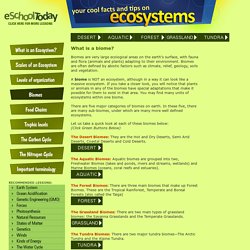

Different Habitat Types. Coniferous forest › Coniferous forests are often found in cool areas in the Northern Hemisphere, such as Canada, Alaska, Scandinavia, and parts of Russia. They are dominated by evergreen fir trees, and are home to animals such as moose (elk), beavers, and wolves. Evergreen trees › The tops of high mountain ranges are extremely cold, and few plants grow there. Animals living in these high places must cope with cold, lack of food, and steep, rocky terrain. Savanna › These tropical grasslands are found in Africa. African savanna › Cold regions near the North and South Poles are covered in ice and snow.
Tropical rain forest › These green, lush forests grow near the Equator (an imaginary line around the middle of the Earth). Amazon rain forest › Hot desert › Deserts are dry places where little plant life can grow. American desert › Tundra › Tundras are frozen solid for most of the year, but thaw out a little during spring and summer. Tundra › Deciduous forest › Deciduous trees › Animal Habitats For Kids. BBC Nature - Habitats. Biomes Facts for Kids. Science for Kids: World Biomes and Ecosystems. What is an ecosystem?

Each individual plant and animal could not exist by itself on planet Earth. All living organisms need millions of other living organisms to survive. How these organisms interact with the sun, soil, water, air and each other in a specific area is called an ecosystem. An ecosystem describes a specific area where the organisms work together as a unit. It could be any size from a tiny pool of water to hundreds of square miles of desert. What is a biome? A biome is way to describe a large group of similar ecosystems. Map of the world biomes - Click on the map to see a larger picture Click on the biomes below to learn more about each one. Land Biomes Aquatic BiomesThe Balance of the Ecosystem Ecosystems maintain important balances in order that all the organisms within the ecosystem can survive.
The sun provides the energy needed by ecosystems. Some important cycles that occur in ecosystems to help maintain proper balance include: Humans and the Ecosystem How can we help? KDE Santa Barbara. Welcome to the Kids Do Ecology Biomes Pages!

Aquatic Biomes | Terrestrial Biomes | GAMES! What are biomes? Biomes are regions of the world with similar climate (weather, temperature) animals and plants. There are terrestrial biomes (land) and aquatic biomes, both freshwater and marine. Would you like to know what the weather is like in different biomes around the world? How many biomes are there? Games Links to more information: Kids Konnect: Biomes Enchanted Learning: Biomes ThinkQuest: Biomes Major Biomes of the World NASA - Mission: Biomes.
What is a biome, and what are the major types on earth? What is a biome?

Biomes are very large ecological areas on the earth’s surface, with fauna and flora (animals and plants) adapting to their environment. Biomes are often defined by abiotic factors such as climate, relief, geology, soils and vegetation. A biome is NOT an ecosystem, although in a way it can look like a massive ecosystem. If you take a closer look, you will notice that plants or animals in any of the biomes have special adaptations that make it possible for them to exist in that area. You may find many units of ecosystems within one biome. There are five major categories of biomes on earth. Let us take a quick look at each of these biomes below: (Click Green Buttons Below) The Desert Biomes: They are the Hot and Dry Deserts, Semi Arid Deserts, Coastal Deserts and Cold Deserts.
The Aquatic Biomes: Aquatic biomes are grouped into two, Freshwater Biomes (lakes and ponds, rivers and streams, wetlands) and Marine Biomes (oceans, coral reefs and estuaries).